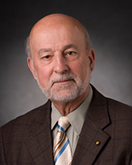
Philip J. Morris, Ph.D.
Boeing, A.D. Welliver Professor of Aerospace Engineering
233C Hammond Building
Penn State University
University Park, PA 16802
Phone: 814-863-0157 / Fax: 814-865-7092
E-mail: pjm@psu.edu
Philip J. Morris grew up listening to planes fly over his house on approach to Heathrow Airport near London, but he didn’t mind the noise as much as he loved the planes. In fact, as soon as he was old enough, he would bike the half hour to the airport with a notebook in which to write down registration numbers. Morris stopped keeping track of the numbers a while ago, but he still likes to watch planes landing and taking off. “I am in awe of aircraft,” he says.
A member of the Penn State Aerospace faculty since 1977 and the Boeing/A.D. Welliver Professor of Aerospace Engineering since 1991, Morris is now a recognized authority on aeroacoustics – aircraft noise– and among his research projects is how to make jet engines quieter without making them any less powerful.
Aircraft noise damages the hearing of people working nearby – most acutely people in the military on the flight decks of aircraft carriers – and annoys neighbors of military and commercial airports. It’s a problem that won’t go away anytime soon because at its root is one of the great unsolved mysteries of physics, how turbulence works. Currently, Morris and his colleagues and students are looking at three potential ways to mitigate noise, and while he has a theoretical basis for understanding how each works, the exact whys and wherefores remain unclear.
“At the present time, even as the field of aeroacoustics has been around for some 50 years, we can’t always predict the noise from a simple round nozzle,” Morris said. “However, we have come a long way in the last five or 10 years.”
One reason for the recent advances is the abandonment of what had been the predominant statistical approach to understanding aeroacoustics in favor of a more physical deterministic approach. The theory behind the new methodology was pioneered by Morris and Christopher Tam, a professor at Florida State University.
All three of the noise mitigation methods under consideration make basic alterations to the shape of the engine’s exhaust nozzle. The first involves the addition of chevrons or serrations to the nozzle exit that modify the structure of the exhaust flow. “No one is really sure why it works, or how well it works in practice,” Morris says. “We think that the chevrons introduce unsteadiness into the turbulence, and that breaks up the large-scale structures without affecting the small-scale structures. We do know you have to be careful about where you introduce the chevrons because sometimes they make things worse.”
This method potentially reduces noise by a factor of two, which sounds like a lot, but Morris explains that in the real world it’s not so dramatic. When he was growing up in the 1950s, jet engines were more than 100 times louder -- relative to the power they delivered -- than they are now.
The second method is a re-design of the nozzle that adjusts the ratio of the exhaust emitted to the throat area of the engine. This reduces broadband shock-associated noise by reducing the mismatch of the pressure at the exhaust to the surrounding air. A lucky side effect of this re-design is that it may actually improve engine performance.
The third method is to alter the geometry of the nozzle by beveling it, or slicing the opening at an angle, effectively shooting the noise in a different direction. This is a case of an old idea regaining currency and has actually been patented by one of Morris’s former students.
The three approaches seem straightforward, but in fact they are beyond state of the art – more like in advance of the art -- and it will probably be a decade before any finds its way into actual commercial application. “These technologies exist about halfway between things that are nearing production and things that may only ever exist on paper,” says Morris. “But university research should be looking 10 or 20 years down the road.”
Morris’s contribution to noise research is theoretical -- he devises the potential solutions based on computational models. At Penn State, the experimental half of the process is under the supervision of Morris’s aerospace colleague, Professor Dennis McLaughlin.
Morris earned his M.S. and Ph.D. degrees in advanced acoustics and aeronautics and astronautics from the University of Southampton, England. By his own admission, he was an indifferent student in grade school whose plan to leave school and become a pilot was undone by the results of an eye test. Initially at university, he indulged in an undeclared major in pub crawling. Sometime during his second year, he realized how much fun engineering could be and that he wasn’t too bad at it. Today, in addition to his extensive research activities, Morris enjoys teaching undergraduate courses, particularly when he has the opportunity to mentor a talented student who is not yet living up to his or her potential.
